For the last few decades, the computer keyboard has been seen as just another peripheral. There’s no need to buy a quality keyboard, conventional wisdom goes, because there’s no real difference between the fancy, ‘enthusiast’ keyboards and ubiquitous Dell keyboards that inhabit the IT closets of offices the world over.
Just like the mechanic who will only buy a specific brand of wrenches, the engineer who has a favorite pair of tweezers, or the amateur woodworker who uses a hand plane made 150 years ago, some people who use keyboards eight or twelve hours a day have realized the older tools of the trade are better. Old keyboards, or at least ones with mechanical switches, aren’t gummy, they’re precise, you don’t have to hammer on them to type, and they’re more ergonomic. They sound better. Even if it’s just a placebo effect, it doesn’t matter: there’s an effect.
This realization has led to the proliferation of high-end keyboards and keyboard aficionados hammering away on boards loaded up with Cherry MX, Alps, Gateron, Topre, and other purely ‘mechanical’ key switches. Today, there are more options available to typing enthusiasts than ever before, even though some holdouts are still pecking away at the keyboard that came with the same computer they bought in 1989.
The market is growing, popularity is up, and with that comes a herculean effort to revive what could be considered the greatest keyboard of all time. This is the revival of the IBM 4704 terminal keyboard. Originally sold to banks and other institutions, this 62-key IBM Model F keyboard is rare and coveted. Obtaining one today means finding one behind a shelf in an IT closet, or bidding $500 on an eBay auction and hoping for the best.
Now, this keyboard is coming back from the dead, and unlike the IBM Model M that has been manufactured continuously for 30 years, the 62-key IBM Model F ‘Kishsaver’ keyboard is being brought back to life by building new molds, designing new circuit boards, and remanufacturing everything IBM did in the late 1970s.
The Rise Of Mechanical Keyboards
The first computer keyboards, found in the Commodore 64, the original Macintosh, and the first PCs were not the keyboards you would find being used today. These keyboards used mechanical switches with moving parts, a satisfying clack but were exceptionally expensive. There was also little standardization; the DEC VT100 terminal used complicated leaf spring switches made by Hi-Tek, the original Macintosh, Commodore Amiga, and Atari 800 used coiled spring switches from Mitsumi. IBM, though their typewriter division, manufactured their own key switches from the 1970s onward, beginning with a conversion of the Selectric typewriter for computer use to beam spring key switches in the 1970s to buckling spring switches in the 1980s.
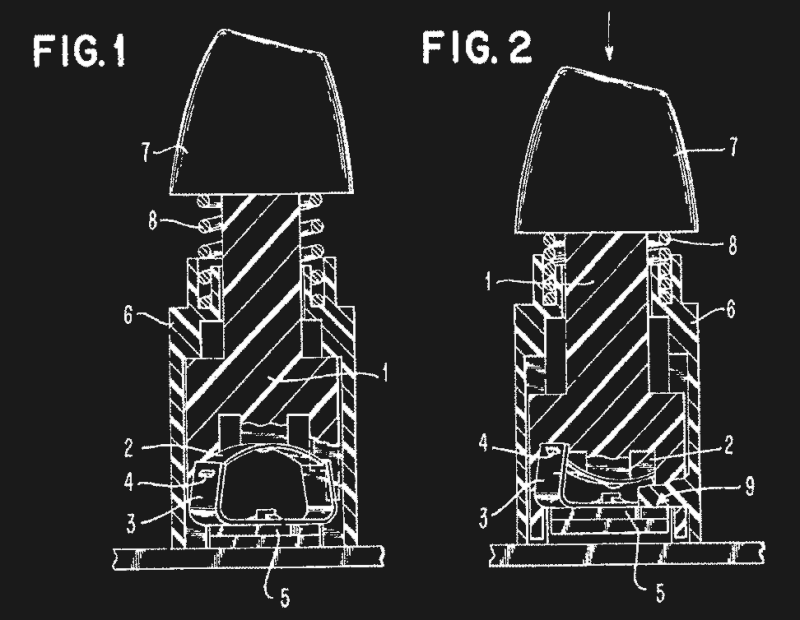
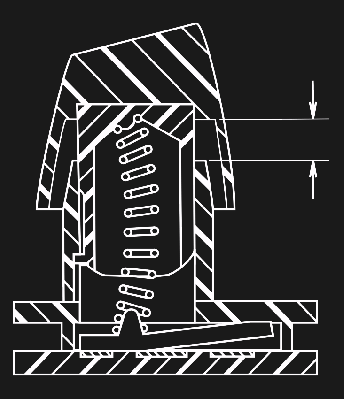
Where the rest of the computer industry would slowly move away from mechanical key switches towards membrane or ‘rubber dome’ switches, IBM was surprisingly steadfast. The IBM Model F, the first keyboard to use buckling springs, would appear on the market with the System/23 in August of 1981, a month before the release of the original IBM PC. The IBM Model M keyboard would replace the Model F in 1985, but the basic mechanism remained the same: a spring would press a rocker in the base of the key, and the sufficient force was applied, the spring would ‘buckle’, pushing the rocker down onto a capacitive contacts or a membrane switch.
The usual mechanical key switch mechanisms found in high-end keyboards today – based on the Cherry MX and ALPS switches – do double duty as leaf springs and electrical contacts. The buckling spring mechanism is baroque in its complexity, relying on a spring and paddle to register a keypress. This complexity is assuredly not the result of building a keyboard down to a price point, and gives the buckling spring keyboards a satisfying tactile feel that only gets better after a few decades of use.
IBM sold the unit responsible for manufacturing the Model M to Lexmark in 1991, and in 1996, the employees at this plant purchased the rights and injection molds to create Unicomp. Yes, you can still buy a Model M keyboard made in Lexington, Kentucky for about the same price as what IBM was selling these keyboards for back in 1986. These are Model M keyboards, though, and the tooling and technology required to produce the arguably superior Model F keyboard disappeared off the face of the planet sometime in the 1980s.
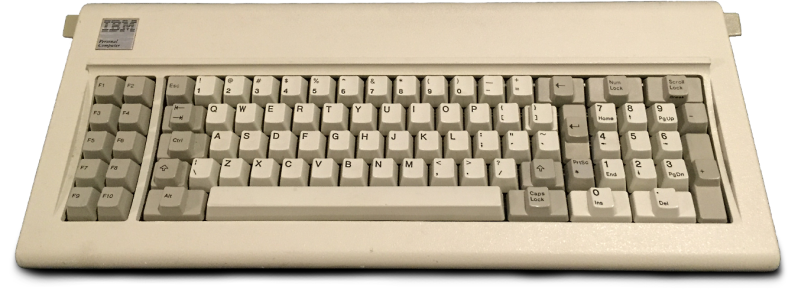
The Kishsaver
IBM’s Model F keyboards look odd to the modern eye. Most keyboards from the 1970s and 1980s do as well. This was a time when keyboard layouts were in flux. Even the most common elements of the computer keyboard were constantly changing in this era. The ‘inverted T’ layout of the arrow keys was first popularized by the DEC LK201 keyboard from 1982, most commonly found in conjunction with the VT-220 terminal. Numpads were fairly common, but the keys underneath the left hand pinky – Control, Alt, Caps Lock, and Tab – wouldn’t be standardized until the mid 1980s. Even the Windows key, or whatever the key between the left Control and Alt keys is called, wouldn’t appear until 1994 with the Microsoft Natural Keyboard.
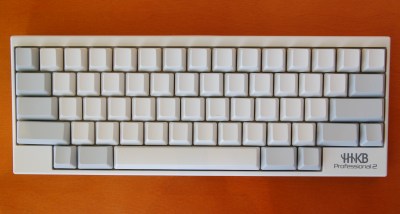
Although keyboard layout designs would standardise around the ANSI or ISO specifications sometime in the late 80s, there were still enthusiasts looking for compact and minimalist keyboards. Numpads weren’t necessary for these people, and everything was more efficient. The Control key was where the Caps Lock key was, as god intended. The Happy Hacking Keyboard, a tiny 60-key keyboard designed for *nix operating systems, became a status symbol. The age of keyboard enthusiasts had arrived.
Sometime around 2012, on a few of the Internet’s largest mechanical keyboard communities, news of a strange IBM keyboard made the rounds. It was small, with just 62 keys, made out of metal, and used the buckling spring key switches of the Model F. It was the IBM 4704, Part Number 6019284. This keyboard was re-discovered by a forum member named Kishy. Since IBM was wont to put a ‘space saver’ label on their smaller keyboards, the portmanteau ‘Kishsaver’ stuck.
The Kishsaver was a true Model F, made of metal, and could serve as an impromptu melee weapon in the event of a zombie apocalypse. It had the IBM aura about it, and it was rare. This wasn’t a keyboard that anyone buying a home computer would have had – this was a keyboard hooked up to terminals and connected to the main office’s mainframe. This was a keyboard that also had a relatively modern layout, and played to the minimalist proclivities of the mechanical keyboard enthusiast. Needless to say, demand outstripped supply, and today a Kishsaver will cost you about $500, if you can find it.
Remanufacturing The Kishsaver
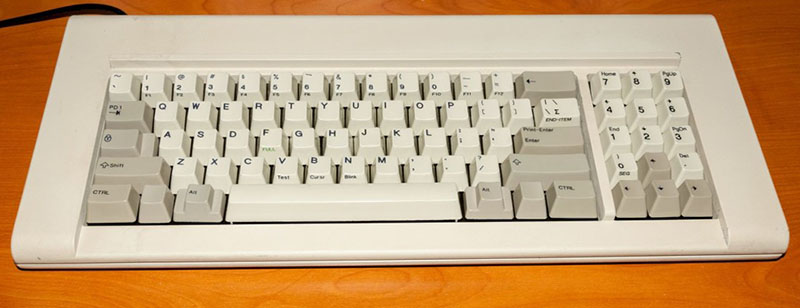
Find any piece of popular, discontinued tech, and you’ll find a replica and reproduction. In the computer world, it’s easy to find a reproduction of the Apple I. This observation extends to classic cars, motorcycles, and even hand tools. It was almost inevitable a classic IBM keyboard would eventually be cloned and remanufactured, all it took was someone to pool their resources, find the people who could do the work, and start a business. All it would take is someone with a little bit of experience.
This person happened to be [Ellipse] on the Geekhack and Deskthority keyboard forums. He’s handled group buys for forum members for open source keyboard controllers that convert the ancient electronics inside IBM keyboards into something that speaks USB. These keyboard controllers were designed by [xwhatsit] as open source alternatives to old electronics boards, but as with so many electronics projects, a lot of people don’t want to deal with Mouser or Digikey orders, and they can’t handle a soldering iron anyway.
With a little bit of manufacturing under his belt, [Ellipse] turned to the Model F Kishsaver. He’s disassembled, repaired, cleaned, and restored a lot of these keyboards over the years, and after carefully measuring his collection of 77- and 122-key Model Fs, he had the data to start talking to manufacturers.
Like any manufacturing project these days, [Ellipse] turned to China. Of course the original molds and dies for the Kishsaver don’t exist anymore, but a lot of the legwork has already been done. The keyboard controller board was already taken care of thanks to [xwhatsit]’s modernization. The Model F keyboard is built around a huge PCB, and with a few Kishsavers floating around, reverse engineering this PCB proved relatively easy.
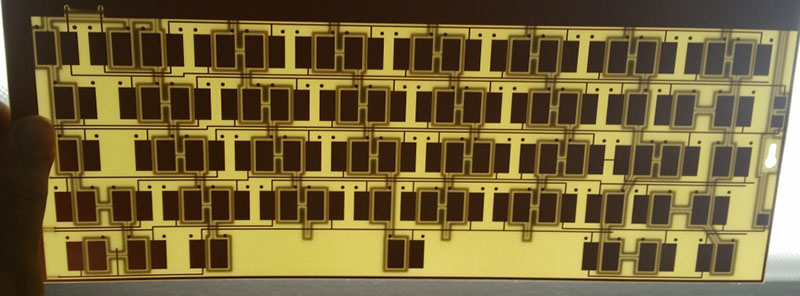
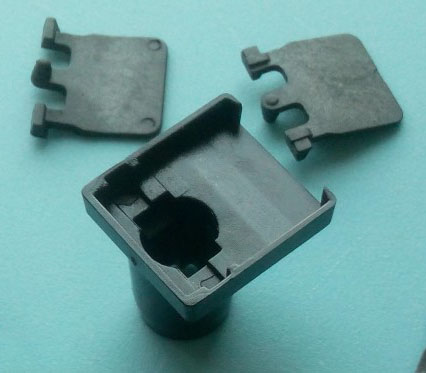
The problem, as with so many projects, is the mechanical design. Molds needed to be made, the right type of plastic for the conductive ‘flippers’ of the buckling spring mechanism needed to be sourced, parts were cast, and dies were formed. New metal cases for the Kishsaver were created and powder coated. If you have an old Kishsaver, every new part is a drop in replacement for the old. Even the styrofoam packaging is a replica; [Ellipse] took measurements of the original IBM packaging materials and replicated with new molds.
The remanufacturing of the IBM Model F 62-key keyboard is among the top achievements among vintage computer enthusiasts. The only comparable project would be an Apple 1 replica built up from parts with late 1975 date codes. It’s an exceptional achievement for the mechanical keyboard community, made even more impressive by the fact that no keyboard manufacturer has taken up Model F manufacturing.

These efforts have culminated in a group buy on the Internet’s major keyboard forums, and an online shop that will sell the 62-key and 77-key Model F for $325 to $376, depending on options. Both the powder coated eggshell and the somewhat anachronistic industrial gray cases are available, with key caps sourced from Unicomp, the current manufacturers of the Model M.
Still, booting up an entire manufacturing line through what is effectively the trust of a community isn’t easy. [Ellipse] says he would like to do die-cast aluminum enclosures, instead of the machined aluminum cases he has now. Die casting would greatly reduce the manufacturing costs, the relatively inexpensive machining of each individual enclosure for the one-time but high cost of producing a steel mold. Still, individually machined enclosures allow for some experimentation, such as the ‘ultra compact’ case design that capitalizes on the modern, smaller controller board and appeals to modern design sensibilities.
For all the hullabaloo about hardware entrepreneurs, the maker movement, crowdfunding, rapid prototyping, and Chinese manufacturing, there aren’t many real success stories. Sure, there are hardware startups coasting on Y Combinator funding, but when it comes to actually producing something people want, there really aren’t many companies out there. For someone who is just an enthusiast, someone who isn’t a programmer, engineer, or product designer to pull a team together to remanufacture the best that came out of IBM in the 1970s is remarkable. It’s a testament to what a community can do, and what a single, dedicated person can achieve.
Title image source: murium on Deskthority

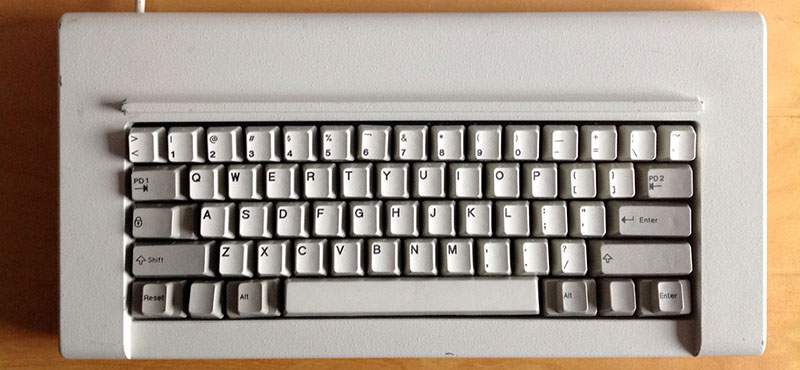













You do know there were computers before the Commodore 64, Apple Macintosh and the IBM PC… right??
How many people used those computers? How specialized and low-volume were their keyboards?
Many and not that specialized. There were less computers before the personal computer period but a lot more terminals per computer.
However that have nothing to do with the post you replied to which correctly points out that “The first computer keyboards, found in the Commodore 64, the original Macintosh, and the first PCs were not the keyboards you would find being used today.” is obviously wrong, the first computer keyboard was “created”* in the 60’s. The idea that all keyboards were “mechanical”** is also wrong, rubber-dome and even designs using foam as the spring mechanism came early.
(* ignoring that terminals, teletypes and modified typewriters was used earlier.)
(** all keyboards are mechanical except a few capacitive and optical ones, non-integrated switch mechanism or per-key mechanism is a better description)
To be fair, Brian just spews controversial claims wildly, with little apparent though to what the implications are.
The point about terminals is a very good one.
Yeah, the one everything else descended from…
https://en.wikipedia.org/wiki/Xerox_Alto
No the Xerox was quite obscure. They’re generally credited with the mouse, but there were lots of other terminals. The IBM 3270 predates the Xerox, and its predecessor, the 2260, dates from 1964.
Still, focusing on the F, rather than the M, is interesting. The F, on the 5150, was the one that really turned our heads, and it, in turn, was reputedly based on the Selectric typewriter. Pretty much *everyone* who cared about keyboards used the Selectric model II – Smith Corona may have owned the home market but IBM owned the business market and essentially every office had a Selectric. Talk about *market share*! For modern use, though, the PS/2 era model M is the go-to — same great feel and durability with a modern layout.
That is comparing apples (or pc’s ;) ) and oranges.
The alto was a complete computer, not just a dumb terminal.
“Even the Windows key, or whatever the key between the left Control and Alt keys is called”.
On most opensource OS, it’s called the “Super key”. But why call it “super” if there is the microsoft logo on it ? I would call it the “dumb key”.
Calling it the Super Key dates back to the Space Cadet Keyboard. Modern keyboards still have Ctrl and Meta (Alt). They also had Hyper. Also three shift modes (Shift, Top, Front).
Except the majority of keyboards are Windows keyboards. I’d bet real money that you can’t find a non-Mac, non-custom keyboard made in the last fifteen years that doesn’t have Windows keys.
can i please have some real money, thank you.
http://www.ttesports.com/Keyboard/19/MEKA/productPage.htm?a=a&g=ftr
Because very few companies make keyboards without windows keys, because why bother when windows is what 90% of your customers are using it’s just a decal on the keyboard that doesn’t actually affect its functioning properly in linux?
Two reasons –
1) The base place that mechanical keys fit into are made with a massive punch press and this is a tool that is too expensive unless you intend to run off thousands of keyboards.
2) The main component is the key switch and you can only buy these from keyboard manufacturers so they are priced so there is little or nothing to save by making your own.
I think it may be you that’s dumb – the logotype is the one for the Windows product. Microsoft starts with a “M” too BTW.
The Symbolics Keyboard had shift,ctrl,meta,super,hyper keys and properly mapped. E.g. when editing text – ctrl-F went forward one letter, meta +1 word, super +1 sentence, hyper +1 paragraph. This worked for all code editing as well.(functions, classes). Very useful actually.
The Help key looked up the comment in the source code and showed it to you. Such a good idea…
Internet history tidbit: At least once Help key was mapped to “No help for you today. Hope for the best”…
I remember the keyboard that came with my IBM 3180 green-screen terminal attached to a System/36 and later an AS400.
24 function keys in 2 rows across the top – each one available for program functions, but also available for local recorded-macro functions. Got some time-consuming, repetitive keystroke combination? Play +F1. Need to type the company name, address, and telephone number on 50 letters a day? Play + F2. Need to type a particular block of code in every module? Play + F3, and so on. IIRC, you could program a pause into a macro, to to enter stuff manually, then continue the macro. Check out the size of this thing:
http://computers.mcbx.netne.net/gallery.php?p=Museum/Terminals/IBM_3180
Looks at my +20 year old keyboard and scratches head… what is that kid on about?
If you want to plug your model F into a modern computer you will find that the protocol changed a bit and the DIN to USB adapters that are sold everywhere do not work.
Just recently I solved that problem how it is solved today: Using a microcontroller with six times the clock frequency of the computer the keyboard was made for: https://github.com/toelke/xt-keyboard-adapter
My first keyboard had an AT/XT switch.
Yes the IBM 4704 keyboard found its way to banks, along with terminals. They were the financial versions of the IBM 3278-2 style terminals. And until the kludges most banks use today came out that’s what was used. IBM is still the go-to brand for computers to run banking. They do use other brands for computers in the banks sadly, and the printers are also made by Lexmark.
When you try to plug a Model F keyboard into a cheap USB converter you will notice that the keyboard protocol has changed a bit. I recently implemented an adapter using a teensy arduino compatible.
Using a microcontroller with six times the clock speed of the computer the keyboard was made for…
https://github.com/toelke/xt-keyboard-adapter
Clever guys–they’re running this crowd funded, but without paying fees. But, you get charged immediately, and I see nothing about refunds if they only get 10 orders (likely….) and can’t afford to manufacture the thing.
According to Ellipse, he’s reached $78000 in orders as of saturday, so i believe MOQ:s shouldn’t be a concern: https://deskthority.net/group-buys-f50/brand-new-f62-kishsaver-f77-industrial-model-f-s-made-this-year-t11046-1560.html#p292354
I don’t think Reactive Light is familiar with the levels of fervor that regularly sweep through the keyboard enthusiast community. In some ways they give audiophiles a run for their money. I’m sympathetic, as I have had a Cherry MX blue equipped keyboard for the last three years, and now rubber dome keyboards make me cry. But I bought it three years ago and I’m still looking for my next keyboard so that I don’t have to take this one to and from work constantly. I would never pay $350 for a keyboard when there are perfectly adequate keyboards in the $70-130 range.
Arg, it would have been nice to have this article run before the early bird deadline for orders, rather than just right after. Oh well, you may have saved me from making a rushed impulse decision.
You can still order for the keyboard and get your keyboard with the early bird round. I
t is just not guaranteed that you recive it in the first round.(The Factory did not yet start producing so there is a real chance for it)
And if you can’t have the hardware, at least these days, you can have the sound of it… :)
https://github.com/zevv/bucklespring
if it’s less than a kilo, i’m out :)
Just put in some scrap iron.
How about some tungsten or (depleted) uranium? Combine with a steel clad cable of suitable length and it can be use as a boat anchor too!
Cool story bro.
No, really, this is a cool story.
A lot of people seem to say that IBM keyboards are the best. I have used several back in the 80s and I am not impressed. They all have that loud ‘click’ sound and takes a lot more effort to type than modern day keyboards. I don’t miss them at all. I think those are the keyboards that are responsible for carpal tunnel syndromes.
You are exactly 100% wrong.
I never even heard of carpal tunnel syndrome, until after all the keyboards went to shit.
Typed on one of my Model M keyboards.
N(samples)=1
You must be exactly 100% right lawl
Which of course applies to both HackJack and RM.
Make that two–also typed on my 27 year old Model M–one of many I own.
“A trolling we will go, a trolling we will go, hi ho the merry-o, a trolling we will go”.
I was a mainframe programmer from ’85-’02. When our offices changed from dumb terminals to PCs one thing EVERY programmer hated was the keyboards on the IBM PCs. They were very good by modern standards and far better than the low rent freebie you get standard with a new machine, but the terminal keyboards were far superior. When you spend your day hammering out COBOL, that matters. I’m glad to see someone is bringing quality back.
I worked at a prison briefly that had a defunct vocational computer training class.
They had over a 100 of the IBM heavy metal keyboards that ended up in a dumpster one day when the warden needed the space cleared.
I was off that day and didn’t find out until I looked in the roll-off dumpster a few weeks later and saw them.
I wish I had grabbed some :(
I actually despised the C64 keyboard…..I’ve never tried a model M or model F, but I imagine the feel is similar. I’ll take Cherry MX blues, or blue Alps any day of the week.
Have you ever tried a Northgate? I haven’t tried Alps, but I recall them being a bit heavier and smoother, but otherwise quite similar to a Cherry MX Blue with meaty keys.
No. The IBM keyboards feel nothing like those C64 keyboards. Their switches are extremely different.
https://youtu.be/IVVgfj1pIFY
Broken image links – have you guys been having problems with broken images lately? For the last month or so, many Hackaday positngs have broken images. This one included – I see a link to : https://hackaday.com/wp-content/uploads/2016/03/ibm_model_f_xt.png – which fails with a “Connection closed”. What’s the dish?
Can you do a screencap of the entire page?
It’s not on our end – although wordpress is the devil.
The collapsing spring keyboards are MUCH better to type on, IMHO, but they are also VERY LOUD. I found that late night coding sessions were disrupting my family’s sleep, so I had to move to quieter designs.
I had a pile of surplus keyboards in 1978. They felt great to use and had hall effect switches in them. The magnets in the key gave them some weight. I have no idea of the brand though. Really wish I’d kept one :( I thought keyboards would improve :(
Improve from magnet and Hall Effect FETs??? What ? With LAZERS ? lol
You posted your ‘lazers’ comment in jest, perhaps not realising the Compucolor II had a keyboard that used an array of photo-diodes and mask patterns inside the keys:
http://www.oldcomputers.net/compucolor-8001.html
Well that is interesting!
I found a teardown of the keyboard; so many little parts…
Opps, forgot link.
https://deskthority.net/photos-f62/collimation-d40-592-t6608.html
The only reason I haven’t bought a Model M from http://www.pckeyboard.com/ (the guys who bought the Model M patents and IP) is because I cant afford one (and because I do a lot of gaming and cant be sure how well the Model M from those guys would work for the kind of gaming I do)
The loudness of the keys may also be a problem if I (for whatever reason) end up sharing a house with other people again.
I like my KeyPro FK-9000. It has the big backspace and the large backwards L enter key. Its only problem is the Prog key is between the right Alt and Ctrl, where the backslash is *supposed to be*. It has the right Shift shortened on its right end to make room for Backslash. It also has a useless key between the left Ctrl and Alt. It’s blank and keyscan testing programs show it produces no output.
It also has an 8-way cursor key surrounding a Turbo key, and a set of 12 programmable function keys on the left where the original PC keyboard had its 10 function keys.
So for a new FK-9000 I’d want to eliminate the useless key, make the right Shift extend all the way to its right and move the Prog key somewhere else. Perhaps a button up by the logo in the upper left or in the upper right by the calculator display.
A calculator?! Yes, built into the keyboard with a switch to toggle between numpad and calculator. Unfortunately KeyPro fell short on that by not giving it a way to send the display contents to the computer. That would be another update to a modern FK-9000.
As for keyboard protocols, the introduction of the IBM PC-AT with its 80286 CPU and capability for more RAM is where the change was made. For some reason IBM put something to do with memory control in the keyboard. Look in older clone motherboards’ BIOS settings for something like Fast A20. Setting that to fast does that function internally on the motherboard. Disabling it shunts it through the keyboard like an old AT. That’s why some newer keyboards don’t work on some olde 286 and later computers from the late 80’s through the 90’s. If the keyboard doesn’t support the A20 function and the computer does not have a Fast A20 BIOS setting – the two won’t work together with a USB>PS/2>AT chain of adapters.
That’s why for a time there were many keyboards with a PC/XT AT switch.
Pretty sure the Gate A20 function used the keyboard controller chip on the motherboard, not the keyboard’s internal controller. What a hack though! The XT / AT switch is because a few keycodes were changed in the AT from XT.
Yes A20 stuff is motherboard local (and a horrible hack on so many levels).
http://i1091.photobucket.com/albums/i382/Comedicles/BitsnPieces/AppleExtKBII_zps1jyijfva.jpg
I think I’m failing at posting an image or a link :-)
A personal favorite. The Apple Extended Keyboard II and arguable the best of show. I have 6 and am converting a pair to USB to cut down on my typo rate.
At home I have a very nice DasKeyboard with Cherry Brown switches and while it is very nice, I really don’t notice any difference in typing speed, quality or comfort with the generic Dell membrane keyboard I used to use.
I know everyone else swears that a mechanical keyboard is head and shoulders above anything else, but I think it depends a lot more on your personal taste. (And I wasn’t entirely happy that I’d just spent almost ten times the cash on a keyboard that was basically the same as my old one).
Absolutely. I own a Model M but readily admit that it’s overbuilt, consumes too much power, and takes up a ton of space. And keyboards rarely fail, even the cheap ones.
I go through lots of keyboards that fail.
First the “;” then the “E” then the space.
So you can guess what I do lol
My Model F AT 6450200 keyboards’s controller board failed about three years ago. I’ve been looking for a replacement board ever since. No luck yet. I have a whatsis controller board and don’t like it.
Great article, this is a wonderful project and nice to see it getting some of the coverage it deserves
I switched to the computer industry just after the release of the IBM XT. Mechanically XT and AT keyboards were the same there were even some that had a switch for XT or AT use. The protocol was different though. The XT keyboard was previously used in one of IBM’s earlier commercial systems and wasn’t redesigned for the XT.
While the XT / AT (earlier) IBM keyboards were good, I found that many terminal keyboards were better. Some terminal keyboards were so robust that you could drive a truck over them and they would be fine.
Unfortunately I can no longer remember model numbers from way back then but perhaps other can.
Surprised that an article about old and interestingly-designed computer keyboards neglected to mention the Sinclair ZX Spectrum 16k/48k. Everything from the key layout to the construction was unusual and innovative. Only 40 keys in total, with letter keys performing 5 different functions depending on context and various shift keys.
Something like 200 functions from 40 keys! Including single-key entry of BASIC keywords. Mostly because typing them out one letter at a time would take too long. It was a hell of a keyboard, the definition of “cheap”.
The ZX81 before it had a flat membrane keyboard. No key movement at all. The ZX80 before that, a load of contacts on the PCB that were bridged by the back of the keyboard, which was a flat layer of plastic with conductive stuff on the back. Not even a membrane.
The Spectrum was an advance on the ZX81, in having a rubber mat above the membrane, with keys moulded in it. Gave you a bit of movement but gods you couldn’t type on it! After that, the 48+ with weird hard plastic keys that weren’t anchored properly, so they returned slowly and would often fall off or get jammed sideways. Underneath the plastic monstrosity though, a membrane.
Meanwhile other computers had proper, actual key switches. Then fast forward a few years to modern PCs and we’re back to membranes again, except by now they’ve actually cracked it, and the keyboards are usable.
Another Sinclair relic was the QL, with a 68008 and 128K RAM, meant to be a “business” computer. Except the same horrible Spectrum 48+ keyboard, so a business computer you can’t actually type on. Really, I despair. Sinclair were great at cheap, not much use at anything else. Still, they’re the reason the UK still punches well above our weight in game development.
Well fuck, I’m pretty sure I’ve thrown at least one of those ultra-rare keyboards in the bin over the years. Then again, I code on a $5 Logitech K120 and it’s absolutely fine, I really can’t see the point of $300+ keyboards and the clicking is annoying.
Mmmm… key binding and mushiness. I bet your coding is super-refined.
I miss my Sun keyboards with the group of keys to the left of the keyboard mapped to cut/copy/paste etc.
I should whip up an adapter. The Sun 2 kbd was anothe metal battleship of a keyboard.
I need to quit reading these articles, they just remind me of the old stuff I’ve had to throw out.
That and the time one guy at the office insisted on annoying everyone else with one old those old clickers.
In 1985-86, Bob (not his real name) and I used smooth, quiet Esprit terminals connected to CP/M portables. After we switched to highly faithful IBM clones, he said the one thing he missed about the old systems was the keyboard. A few years later we got systems with less clackety keyboards and he said he missed the clackers. So sometimes it’s just conditioning. I’m only particular about layout — I held doggedly onto anything with Ctrl in the home row until I discovered remapping.
I have a buckling switch keyboard from Unicomp.com and I LOVE IT. I had a box of old IBM PS/2 keyboard, but alas, AT & PS/2 keyboard connections are gone. The Unicomp is amazing and has the same feel as my original IBM keyboards. Love it! (-:
I ordered one of the new Model M’s from Unicomp. 2 days after it arrived, I scored a genuine IBM Model M in pristine condition at an estate sale for $5. Murphy’s law.
I miss the RGB backlighting and macro keys of some of my other expensive mechanical keyboards, but I cannot deny that my typing speed and accuracy is much better on the buckling springs. None of the tactile Cherry (and clone) type switches gives as good of a tactile and auditory click as the springs do. And I’d say the modern Unicomp is just as good as the original IBM.